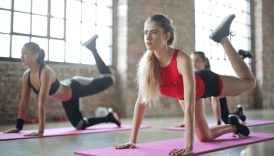George’s Guide to Nutritious Eating and Active Living

George’s Journey to Health
George found himself at a crossroads when he realized that his busy lifestyle was taking a toll on his health. As a once-active individual, he noticed he’d become increasingly reliant on fast food and sugary snacks. At his highest weight, he felt sluggish and unmotivated. Determined to make a change, George embarked on a journey towards better health, focusing primarily on balanced nutrition. Along this journey, George learned to appreciate the power of wholesome foods and how they could energize his body. He began meal prepping and rediscovered the joy of cooking.
- George’s Guide to Nutritious Eating and Active Living
- George's Journey to Health
- Importance of Balanced Nutrition
- Understanding Nutrients
- Macronutrients
- Micronutrients
- Building a Healthy Plate
- Food Groups to Include
- Portion Control Tips
- Meal Planning
- Weekly Menu Ideas
- Grocery Shopping Tips
- Importance of Hydration
- Benefits of Drinking Water
- Hydration Tips for Active Living
- The Role of Physical Activity
- Types of Exercise
- Creating a Fitness Routine
- Mindful Eating Habits
- Eating Without Distractions
- Listening to Hunger Cues
- Managing Stress
- Impact of Stress on Health
- Stress-Relief Strategies
- Getting Quality Sleep
- Importance of Sleep for Overall Health
- Tips for Improving Sleep Quality
- Building a Support System
- Benefits of Accountability Partners
- Joining a Health Community
Importance of Balanced Nutrition
Balanced nutrition plays a crucial role in maintaining overall health and well-being. Here are a few key benefits that George experienced:
- Energy Boost: Eating a variety of foods, including fruits, vegetables, whole grains, and proteins, provided him with essential energy throughout the day.
- Weight Management: With balanced meals, George found that controlling his weight became much more manageable.
- Enhanced Mood: Proper nutrition positively impacted George’s mental health, helping him to feel more motivated and focused.
Embracing balanced nutrition can pave the way for a healthier, more vibrant life, just as it did for George. By making simple changes to his diet, he not only improved his physical health but also enhanced his overall quality of life.
Understanding Nutrients
Macronutrients
As George adjusted his diet, he quickly learned about the importance of macronutrients — the building blocks of a healthy diet. Understanding macronutrients helped him balance his meals effectively. There are three main types:
- Carbohydrates: Often viewed as the enemy in diets, George discovered that whole grains, fruits, and vegetables provided essential energy for his active lifestyle.
- Proteins: Essential for muscle repair and growth, George made sure to include lean meats, legumes, and dairy products in his meals, helping him feel fuller for longer.
- Fats: Healthy fats, such as those found in avocados, nuts, and olive oil, became a staple in George’s diet, contributing to overall heart health.
Micronutrients
While macronutrients are crucial, George also learned about the significance of micronutrients — vitamins and minerals that support various bodily functions. He started incorporating a rainbow of fruits and vegetables into his meals, which offered:
- Vitamins: Vital for immune function, energy production, and skin health.
- Minerals: Necessary for bone health, fluid balance, and nerve transmission.
By understanding these essential nutrients, George was better equipped to nourish his body, promote health, and feel his best every day. Balancing both macronutrients and micronutrients allowed him to transform his diet and, ultimately, his life.
Building a Healthy Plate
Food Groups to Include
As George continued his journey towards better health, he realized the importance of building a balanced plate at each meal. He learned to include a variety of food groups to maximize nutrition. Here’s what he focused on:
- Fruits and Vegetables: Aiming for half his plate, George loved colorful salads and steamed veggies for their vitamins and minerals.
- Whole Grains: Switching white rice for quinoa and white bread for whole grain, he found they kept him fuller and energized.
- Lean Proteins: Incorporating sources like chicken, fish, and beans ensured he got the protein needed for recovery and satiety.
- Healthy Fats: Adding a handful of nuts or a drizzle of olive oil provided essential fats that his body craved.
Portion Control Tips
Along with the right food groups, George discovered key portion control tips to help manage his intake:
- Use Smaller Plates: This simple trick made his portions appear larger and helped him eat less without feeling deprived.
- Listen to His Body: Paying attention to hunger cues allowed him to recognize when he was satisfied, preventing overeating.
- Pre-portion Snacks: George started preparing snack sizes in advance, making it easier to grab healthy options on the go.
By focusing on food groups and mastering portion control, George not only improved his diet but also ensured he was enjoying meals without the stress of overindulgence.
Meal Planning
Weekly Menu Ideas
As George adapted his lifestyle for better health, he discovered the magic of meal planning. Not only did it streamline his grocery shopping, but it also saved him time during the week. He began creating a simple weekly menu that included:
- Monday: Quinoa salad with chickpeas and mixed vegetables.
- Tuesday: Grilled chicken with steamed broccoli and brown rice.
- Wednesday: Vegetable stir-fry with tofu and whole-grain noodles.
- Thursday: Baked salmon with roasted sweet potatoes and asparagus.
- Friday: Taco night with lean ground turkey and plenty of toppings.
This approach allowed George to stay organized, eat healthier, and avoid the temptation of fast food.
Grocery Shopping Tips
To make the most out of his meal planning, George also picked up some essential grocery shopping tips:
- Make a List: He always prepared a shopping list based on his weekly menu, reducing impulse buys.
- Shop the Perimeter: Focusing on the outer edges of the store meant he filled his cart with whole foods while minimizing processed items.
- Buy Seasonal: George saved money and enjoyed fresher produce by choosing seasonal fruits and vegetables.
By implementing these meal planning strategies, George took full control of his diet and was well on his way to achieving his health goals.
Importance of Hydration
Benefits of Drinking Water
As George progressed on his health journey, he quickly learned that hydration is just as important as nutrition. Drinking enough water brought numerous benefits that transformed his overall well-being. Key benefits he experienced included:
- Increased Energy Levels: Staying hydrated improved George’s stamina during workouts and kept fatigue at bay.
- Better Digestion: Water helped him avoid constipation and maintained a healthy digestive system, supporting his weight loss efforts.
- Enhanced Mood: Proper hydration positively impacted George’s mood, making him feel more focused and less irritable throughout the day.
Hydration Tips for Active Living
To maintain hydration, George implemented some practical tips that worked well with his active lifestyle:
- Carry a Water Bottle: He began carrying a reusable water bottle wherever he went, making it easier to sip throughout the day.
- Set Reminders: Using his phone to set hydration reminders helped him remember to drink water, especially during busy days.
- Infuse with Flavor: To make hydration enjoyable, George experimented with adding slices of lemon or cucumber to his water, making it a refreshing treat.
Emphasizing hydration, paired with his nutrient-rich meals, allowed George to fuel his body effectively for an active lifestyle, proving that water truly is vital for achieving health goals.
The Role of Physical Activity
Types of Exercise
As George’s health journey progressed, he discovered that physical activity is a vital component of maintaining wellness. He learned about various types of exercise that can be tailored to individual preferences and fitness levels. Here are some key categories he explored:
- Cardiovascular Exercise: Activities like running, cycling, or dancing increased his heart rate and improved his endurance.
- Strength Training: George began incorporating weightlifting and bodyweight exercises to build muscle, which also helped with weight management.
- Flexibility Exercises: Yoga and stretching routines enhanced his flexibility and reduced the risk of injury.
Creating a Fitness Routine
To make the most of his physical activity, George devised a structured fitness routine that kept him motivated and accountable. His approach included:
- Scheduling Workouts: He reserved specific days and times for exercise, treating them like important appointments.
- Setting Realistic Goals: George established achievable fitness goals, such as increasing his running distance or completing a certain number of strength training sessions each week.
- Incorporating Variety: To keep things exciting, he alternated between different types of workouts, preventing boredom.
By embracing the role of physical activity in his life and committing to a fitness routine, George not only enhanced his physical health but also boosted his mental and emotional well-being.
Mindful Eating Habits
Eating Without Distractions
With his new focus on physical activity, George recognized that the way he approached his meals was just as crucial. He learned about mindful eating, which transformed his relationship with food. One significant aspect was eating without distractions. George made conscious changes to his eating habits by:
- Setting a Dedicated Eating Space: He began enjoying meals at the dining table rather than in front of the TV, creating an environment conducive to mindfulness.
- Putting Away Devices: By silencing his phone and avoiding screens, he was more present in the moment, allowing him to appreciate each bite.
- Chewing Slowly: George found that taking time to chew his food thoroughly not only enhanced flavors but also helped him recognize when he was satisfied.
Listening to Hunger Cues
Along with minimizing distractions, George learned the importance of listening to his body’s hunger cues. He embraced the following strategies:
- Distinguishing Between Hunger and Thirst: He started to pay attention to whether he felt hungry or merely dehydrated, often reaching for a glass of water first.
- Eating When Hungry: Instead of sticking rigidly to pre-set meal times, George began eating only when he genuinely felt hungry, which reduced unnecessary snacking.
- Stopping When Full: Learning to stop eating when he felt satisfied, rather than stuffed, helped him avoid overeating and enjoy his meals more.
By adopting these mindful eating habits, George improved his relationship with food, leading to a healthier lifestyle and a newfound appreciation for nourishing his body.
Managing Stress
Impact of Stress on Health
On his journey toward wellness, George realized that managing stress was crucial for maintaining both mental and physical health. He learned that chronic stress could have significant negative impacts, including:
- Weight Gain: Stress led George to unhealthy eating patterns, often causing him to reach for comfort foods.
- Sleep Disruption: High stress levels contributed to sleepless nights, leaving him feeling fatigued during the day.
- Reduced Immunity: George discovered that constant stress took a toll on his immune system, making him more susceptible to illness.
Stress-Relief Strategies
To combat these effects, George implemented various stress-relief strategies that made a noticeable difference in his life:
- Regular Exercise: He found that physical activity, whether it was a brisk walk or a workout session, helped release endorphins, alleviating stress.
- Mindfulness Practices: George dedicated time each day to mindfulness techniques, such as meditation and deep breathing. This practice grounded him and allowed him to approach daily challenges with a clearer mind.
- Connecting with Nature: Taking time to enjoy outdoor activities, like hiking or gardening, brought a refreshing perspective and reduced feelings of stress.
Through these strategies, George successfully managed stress, allowing him to focus on his health journey with renewed vigor and a positive mindset.
Getting Quality Sleep
Importance of Sleep for Overall Health
As George continued to prioritize his health, he discovered that sleep was a fundamental component of his well-being. He learned that quality sleep is crucial for various aspects of health, including:
- Physical Recovery: Adequate sleep helps the body repair muscles and tissues, making it essential for recovery after workouts.
- Mental Clarity: George found that a good night’s sleep improved his focus, memory, and decision-making abilities.
- Emotional Stability: Quality rest contributed to a better mood and reduced feelings of anxiety and stress, further enhancing his overall mental health.
Tips for Improving Sleep Quality
To ensure he was getting restful sleep, George adopted several practical tips that have since made a significant difference in his nightly routine:
- Establish a Sleep Schedule: Going to bed and waking up at the same time daily helped regulate his body’s internal clock.
- Create a Relaxing Bedtime Routine: George began winding down with calming activities, such as reading or gentle stretching, signaling to his body that it was time for sleep.
- Limit Screen Time: He made a habit of turning off electronics an hour before bed to minimize blue light interference, enhancing his ability to fall asleep.
These strategies not only improved George’s sleep quality but also played a vital role in supporting his overall health, making him feel more invigorated and ready to tackle each day.
Building a Support System
Benefits of Accountability Partners
As George embraced a healthier lifestyle, he realized that building a strong support system was vital for his continued success. One of the most significant components was having accountability partners. These are friends or family members who share similar goals and can help keep each other motivated. Here are a few benefits George experienced:
- Consistent Motivation: Having someone to check in with each week inspired George to stick to his fitness and nutrition plans.
- Shared Progress: Celebrating milestones together, like reaching a fitness goal or trying a new healthy recipe, made the journey more enjoyable.
- Support in Challenges: Whenever George faced setbacks, his accountability partner was there to provide encouragement and practical advice.
Joining a Health Community
In addition to his everyday support system, George took a further step by joining a local health community. This experience opened up even more avenues for support:
- Resource Sharing: He gained access to resources like workout classes, nutrition workshops, and meal prep groups.
- Group Activities: Participating in community fitness events made working out fun and introduced George to like-minded individuals.
- Inspiration: Hearing success stories from others motivated George to push through his own challenges.
By building this robust support system, George not only made his health journey enjoyable but also surrounded himself with individuals who uplifted him, ensuring he stayed on track toward his goals.





